NetSuite is a popular business management suite that delivers efficient ERP, CRM, and other e-commerce solutions to nearly 25000 customers worldwide.
This document guides you in setting up NetSuite as a source in RudderStack. Once configured, RudderStack automatically ingests your specified NetSuite data, which can then be routed to your RudderStack-supported data warehouse destination.
Configuring NetSuite
Before you set up a Netsuite source in RudderStack, there are some RudderStack-specific configurations you need to do in your Netsuite account.
Allowlisting the IPs
Depending on the setup of your NetSuite organization, you will have to allowlist the following RudderStack IPs:
- 3.216.35.97
- 34.198.90.241
- 54.147.40.62
- 23.20.96.9
- 18.214.35.254
To allowlist the IPs in NetSuite, follow these steps:
- Sign into your NetSuite account as an administrator.
- Go to Setup > Company > Company Information.
- Add a comma-delimited list of the above-mentioned RudderStack IPs in the Allowed IP addresses field.
- Finally, click on Save.
Enabling token-based authentication
You will also need to enable token-based authentication for your NetSuite account in order to generate tokens and authenticate the SuiteTalk API.
To do so, follow these steps:
- Locate the Manage Authentication option in the Enable Features page.
- Enable (check) the Token-based Authentication box.
- Finally, scroll to the bottom and click on Save.

Creating an integration
Next, create an integration record for RudderStack to uniquely identify RudderStack in your NetSuite account.

Follow these steps to create a new integration:
- Go to Setup > Integration > Manage Integrations > New.
- In the New Integration page, enter the following fields:
- Name: Enter a name for your integration.
- State: This field should be Enabled.
- In the Authentication tab, enable (check) Token-based Authentication.
- Finally, click on the Save button. The confirmation page will display a Consumer key/secret section, as shown:
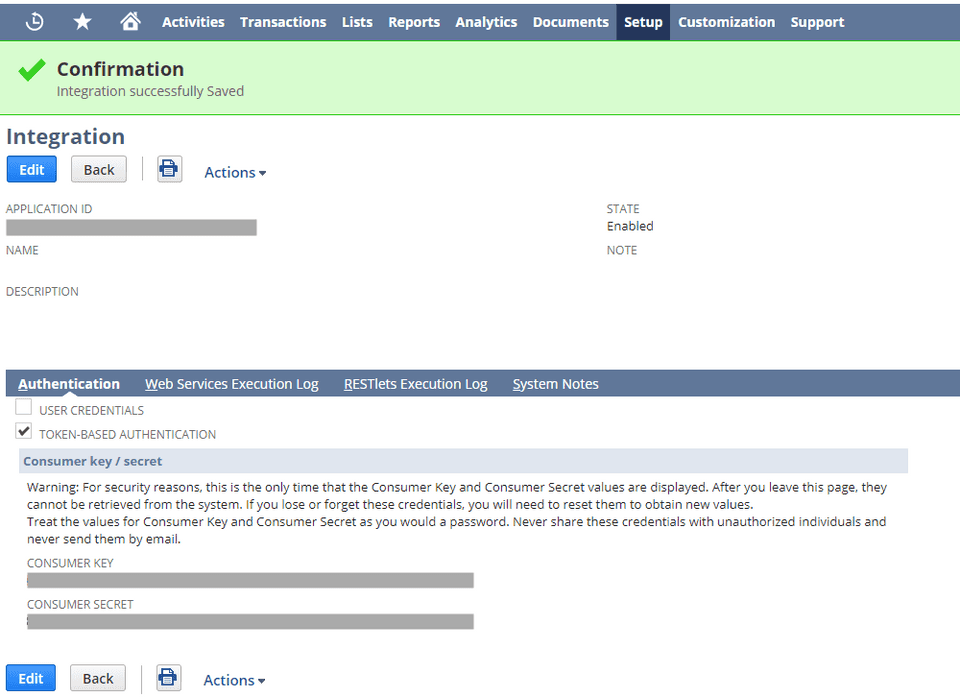
Creating a NetSuite role and configuring permissions
To create a NetSuite Token ID and Secret, you first need to create a Role for RudderStack and an Employee with this specific role.
Step 1: Creating a role
To create a new role, follow these steps:
- Go to Setup > Users/Roles > Manage Roles > New.
- Enter a name for the role in the Name field, for example,
RudderStack. - Select Two-Factor Authentication Required to Not Required.
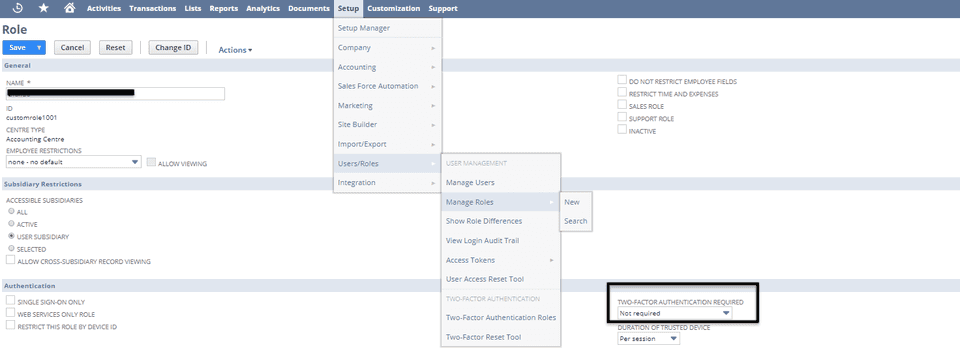
- Under the Permissions section, go to Setup and assign the following permissions:
| Full permissions | View permissions |
|---|---|
| Web Services | Custom Fields |
| User Access Tokens | Custom Body Fields |
| Log In Using Access Tokens | Perform Search (this can be found in the Lists section next to Setup) |
| Deleted Records | - |

For each pipeline resource that you want RudderStack to sync, you should give the relevant permissions for it to the role. These resources are divided among the following sections:
- Transactions
- Reports
- Lists
- Custom Records.
Note that each permission should have View level.
It is extremely important that you have assigned the permissions for every resource, saved search or custom record that you want RudderStack to sync. This is required so that you don't encounter any RudderStack sync failures with permission-related issues.
Step 2: Creating an employee
To create a new employee, follow these steps:
- Navigate to Lists > Employees > Employees > New.
- Then, enter the name and email ID of the employee.
- Under the Access section, enable (check) Give Access and Manually assign or change password. Then add the required password.
- Finally, add the Role which you have created in the previous step and click on Save to save the settings.
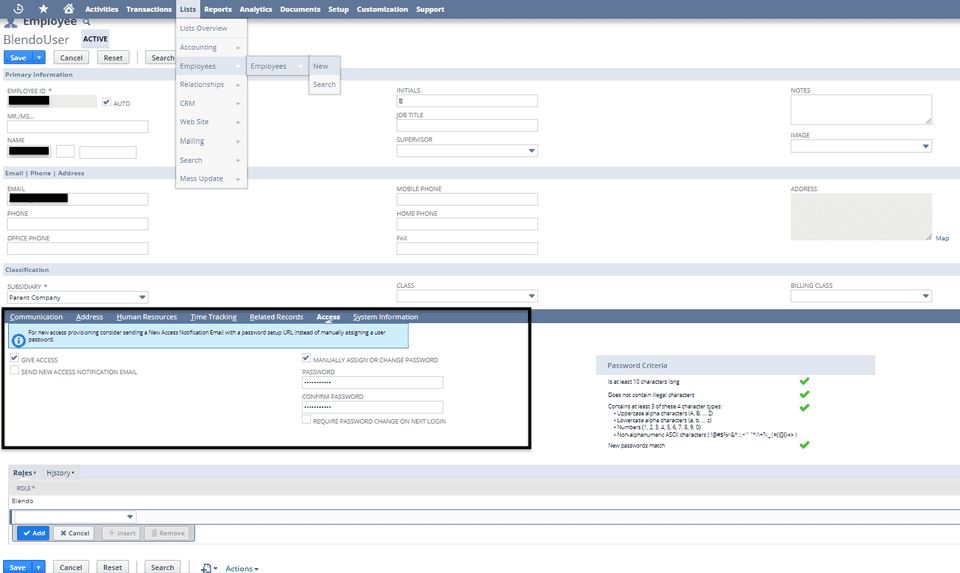
Step 3: Creating an access token
In this step, you will need to generate the access tokens required for the integration record (application) and the user role.
To generate the access token, you may have to first log in as this user.

- Go to Setup > Users/Roles > Access Tokens > New.
- Then, enter the following settings:
- Application Name: Select the integration record you created.
- User: Select the user you created.
- Role: Select the role you created.
- Token Name: Assign a name for the token.
- Finally, click on the Save button. The confirmation page will display a Token ID and Secret, as shown:
For security reasons, this is the only time these credentials will be displayed. Hence, copy and store the Token ID and Token Secret safely. You will need these credentials while setting up the NetSuite source in RudderStack.

Locating your NetSuite Account ID
To locate your NetSuite account ID, go to Setup > Integration > Web Services Preferences.
You will find the account ID in the resulting page, as highlighted below:
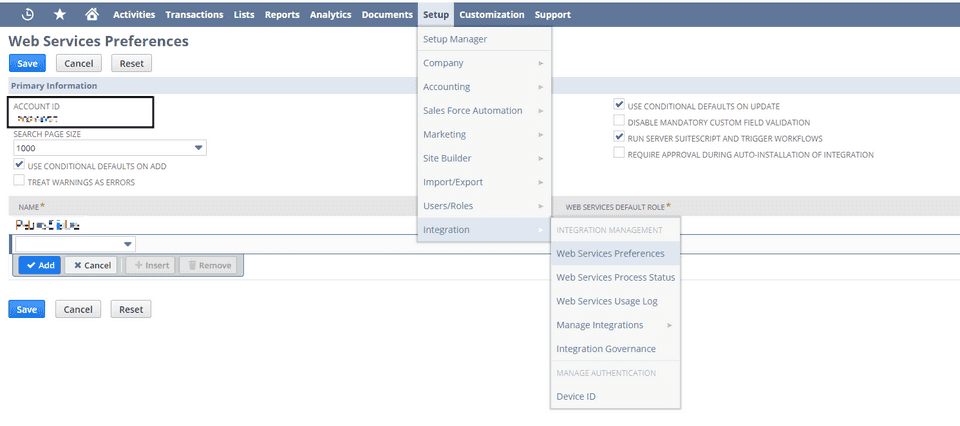
1234567_SB2, it should be included when you enter the ID during the source configuration in RudderStack.Configuring NetSuite source in RudderStack
To set up NetSuite as a source on the RudderStack dashboard, follow these steps:
- Log into your RudderStack dashboard.
- Go to Sources > New source > Cloud Extract and select NetSuite from the list of sources.
- Assign a name to your source and click on Next.
Connection settings
Enter the following connection credentials required to set up your NetSuite source in RudderStack:
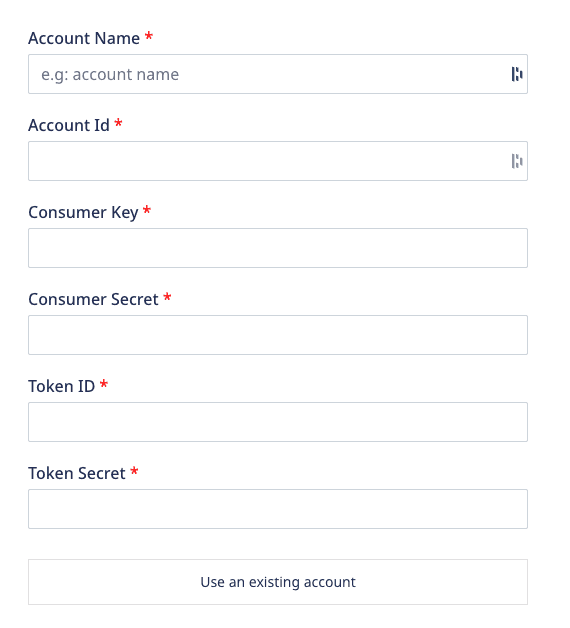
- Account Name : Enter your NetSuite account name here. You can get it from your NetSuite dashboard.
- Account ID : Enter the NetSuite account ID. You can get the account ID by going to your NetSuite dashboard and navigating to Setup > Integration > Web Services Preferences. For more information, refer to the Locating your NetSuite Account ID section above.
- Consumer Key : Enter your NetSuite consumer key.
- Consumer Secret : Enter your NetSuite consumer secret.
For more information on getting your NetSuite consumer key and secret, refer to the Creating an integration section above.
- Token ID : Enter your NetSuite token ID.
- Token Secret : Enter your NetSuite token secret.
For more information on getting your NetSuite token ID and secret, refer to the Creating an access token section above.
Setting the historical sync date
Set the Historical sync start date from when you want RudderStack to sync all your historical NetSuite data. Also specify the RudderStack Restlet URL and click Next, as shown:
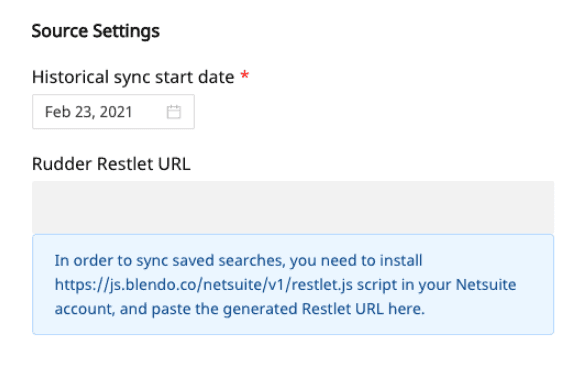
To get the RudderStack Restlet URL, you need to first install this script in your NetSuite account and paste the generated restlet URL in the RudderStack dashboard. For more information on adding the script in your NetSuite account, refer to the FAQ section below.
Destination settings
The following settings specify how RudderStack sends the data ingested from NetSuite to the connected warehouse destination:
- Table prefix: RudderStack uses this prefix to create a table in your data warehouse and loads all your NetSuite data into it.
- Schedule Settings: RudderStack gives you three options to ingest the data from NetSuite:
- Basic: Runs the syncs at the specified time interval.
- CRON: Runs the syncs based on the user-defined CRON expression.
- Manual: You are required to run the syncs manually.
For more information on the schedule types, refer to the Common Settings guide.
Selecting the data to import
Finally, you need to select the NetSuite data that you wish to ingest via RudderStack. You can either select all the data, or choose specific NetSuite data attributes, as per your requirement, as shown:
Note that none of the resources are selected by default, so you will have to do the selection manually.
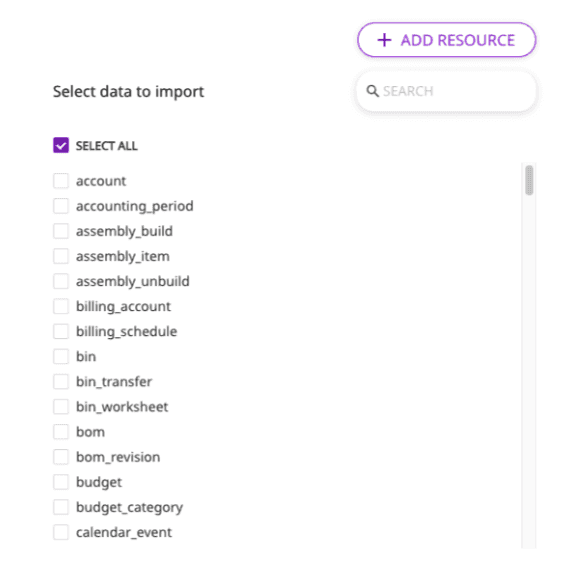
Importing custom records and saved searches
RudderStack supports two special types of resources that you can ingest from NetSuite, namely custom records and saved searches. To import these resources, click on Add Resource on the top right, as shown above. You will see the following window:
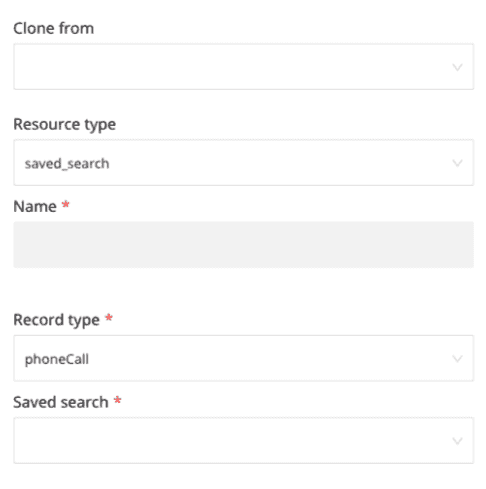
- If you have already configured a NetSuite resource before, you can choose the Clone from option to use the values of that resource as is.
- Alternatively, select the appropriate Resource type you want to import:
- For a saved_search, enter a Name for the resource, select the Record type present in your NetSuite account, and the exact Saved search that you have created there.
- For a custom_record, enter a Name for the resource and select the custom record that is present on your NetSuite account.
- Finally, save the information by clicking on Save.
NetSuite is now configured as a source. RudderStack will start ingesting data from NetSuite as per your specified schedule and frequency.
You can further connect this source to your data warehouse by clicking on Add Destination, as shown:

Use the Use Existing Destination option if you have an already-configured data warehouse destination in RudderStack. To configure a data warehouse destination from scratch, select the Create New Destination button.
FAQs
How can I get the RudderStack Restlet URL?
To get the RudderStack Restlet URL, you need to first install this script in your NetSuite account and paste the generated restlet URL in the RudderStack dashboard.
To create a new Script in your NetSuite account, follow these steps:
- Go to Customization > Scripting > Scripts > New.
- Then, click on the + icon to create a new script.
- A new window will then pop up asking you to select the downloaded script.
- Once you have attached it, click on Save, and then click on Create Script Record.
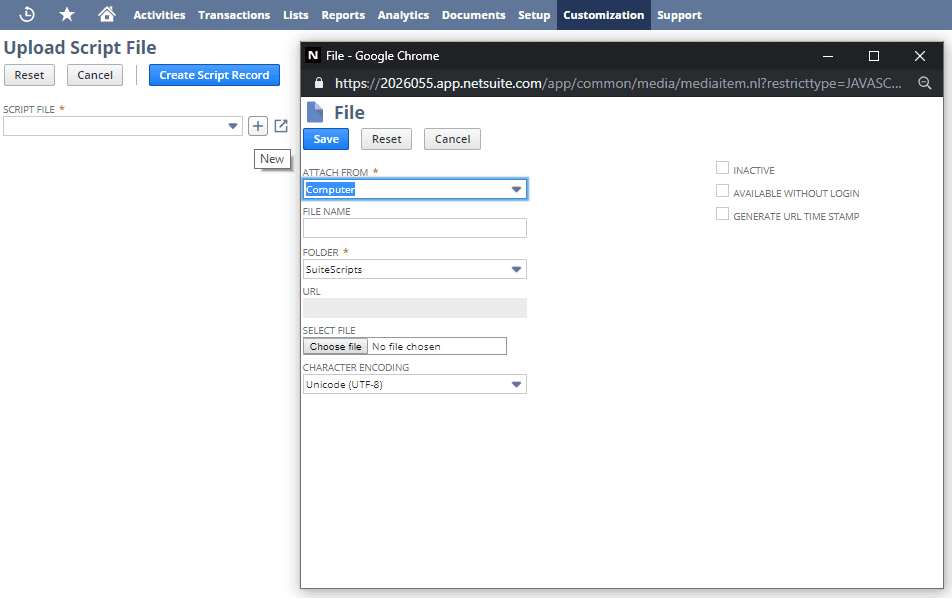
- Then, add the Name of the script and the Owner, that is the Employee that you created in the Creating an employee section above. Then click on Save.

- To deploy the script, click on Deployments, add the script Title, and click on Add. After the script is deployed, click on Save.

- Finally, click on the title of your deployed script. You should be able to see the External URL, which is the RudderStack Restlet URL that you need to use in the NetSuite source configuration.

Is it possible to have multiple Cloud Extract sources writing to the same schema?
Yes, it is.
RudderStack associates a table prefix for every Cloud Extract source writing to a warehouse schema. This way, multiple Cloud Extract sources can write to the same schema with different table prefixes.
Contact us
If you come across any issues while configuring NetSuite as a source in RudderStack, you can contact us or start a conversation in our Slack community.